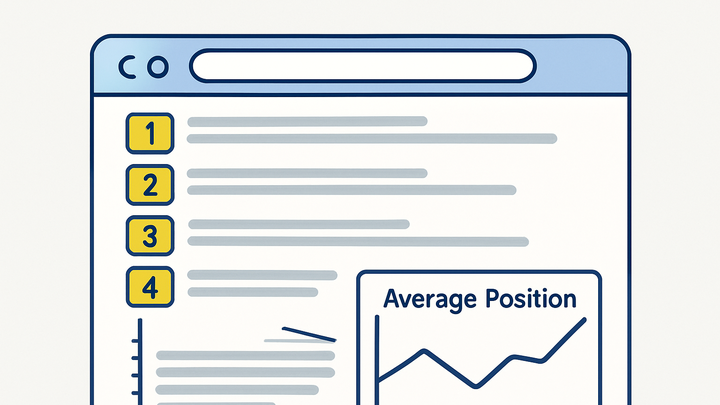Published on 2025-06-22T06:40:59Z
What is Average Position in Analytics? Examples in GA4 and PlainSignal
Average Position is a key performance metric in search analytics, indicating where on average your website’s pages or ads appear in search engine results pages (SERPs). Lower values (closer to 1) mean higher rankings and typically yield better visibility and click-through rates. In Google Analytics 4 (GA4), Average Position can be accessed by linking your property to Google Search Console, importing data into the ‘Search Console Queries’ reports. PlainSignal, a lightweight cookie-free analytics tool, focuses on page views and events but does not natively track search rank; however, you can extend it by pushing custom events with position data from external sources.
Here’s how you might integrate PlainSignal on your website:
<link rel="preconnect" href="//eu.plainsignal.com/" crossorigin /><script defer data-do="yourwebsitedomain.com" data-id="0GQV1xmtzQQ" data-api="//eu.plainsignal.com" src="//cdn.plainsignal.com/plainsignal-min.js"></script>
By combining GA4’s Search Console integration with PlainSignal’s lightweight tracking, you can gain a comprehensive view of both user behavior and organic ranking performance across your site.
Average position
Average Position is the mean rank of your pages or ads in search results, reflecting overall visibility and performance.
Definition of Average Position
This section explains what average position means in search analytics, how it is calculated, and how to interpret the numeric value.
-
Basic concept
Average Position measures the mean rank of your website’s search listings (organic or paid) across all impressions. It is calculated by summing the positions of each impression and dividing by total impressions. A lower numeric value indicates a higher ranking.
-
Numeric interpretation
Positions start at 1 (the top result). An average position of 3.5 means that, across all impressions, your results appeared between the third and fourth positions. Fractional values arise because this metric is an average over many queries and impressions.
Why Average Position Matters
Understanding average position helps you gauge your overall visibility on search engine results pages (SERPs) and optimize your SEO or PPC strategies accordingly.
-
Visibility and click-through rate
Higher average positions (closer to 1) generally generate more organic clicks, as users are more likely to click top-ranked listings. Tracking this metric helps you correlate ranking with click-through rate (CTR).
-
Performance benchmarking
Monitoring average position over time allows you to benchmark your SEO or paid search performance against competitors and measure the effectiveness of optimization efforts.
Measuring Average Position in Google Analytics 4
While GA4 doesn’t calculate average position natively, you can import Search Console data or define custom metrics to view this data within your GA4 property.
-
Linking search console to GA4
In GA4 Admin, go to Product Links, select Search Console, and follow the prompts to connect your site. Once linked, average position data flows into the ‘Search Console Queries’ reports under Acquisition.
-
Admin › product links
Open your GA4 property, click Admin, and choose Product Links to start the linking process.
-
Select search console
Choose your Search Console property, grant permissions, and complete the setup to import search metrics.
-
-
Analyzing reports
Navigate to Acquisition > Search Console > Queries to view impression, click, CTR, and average position data. Use filters and date ranges to segment by query, page, device, or location.
Using PlainSignal for Simple Search Analytics
PlainSignal is a lightweight, cookie-free analytics solution for monitoring page views and custom events. Although it doesn’t include average position out of the box, you can enrich its data with custom events capturing search ranking information.
-
Integrating PlainSignal
Add the PlainSignal script to your site to start capturing analytics data:
<link rel="preconnect" href="//eu.plainsignal.com/" crossorigin /> <script defer data-do="yourwebsitedomain.com" data-id="0GQV1xmtzQQ" data-api="//eu.plainsignal.com" src="//cdn.plainsignal.com/plainsignal-min.js"></script> -
Custom event tracking
Fetch average position data from the Search Console API or another rank-tracking tool, then push it as a PlainSignal event:
plainSignal('event', 'search_rank', { query: 'analytics term', position: 4 });
Best Practices and Common Pitfalls
Accurate collection and interpretation of average position data require caution. This section highlights practical tips and warns against common mistakes.
-
Data sampling and variability
Search Console may sample data for high-traffic sites, causing approximate average positions. Use consistent date ranges and be aware of sampling thresholds.
-
Comparing like with like
Avoid comparing average positions across different query sets, devices, or geographies without proper segmentation. Consistency in segments ensures meaningful comparisons.
